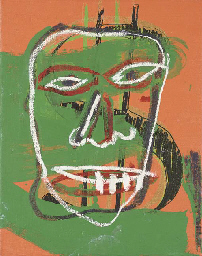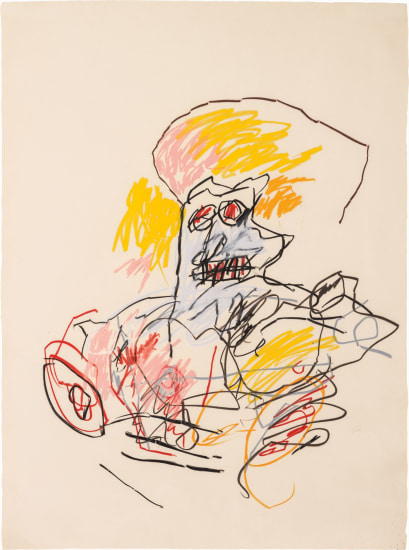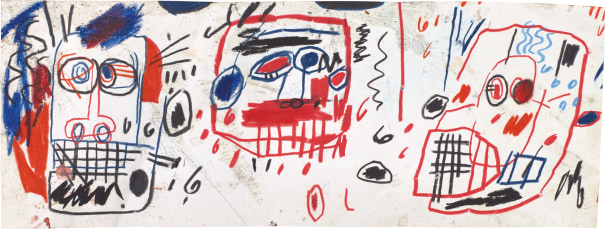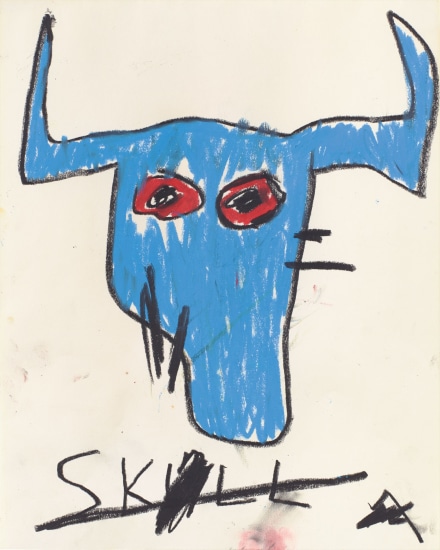Jean-Michel-Basquiat and Andy Warhol Thin Lips 1984-1985 Synthetic polymer paint and oil stick on canvas. 195.6 × 157.5 cm (77 × 62 in). Stamped with The Estate of Andy Warhol stamp and the stamp of The Andy Warhol Foundation for the Visual Arts on the overlap (PA99.048).
Provenance The Estate of Andy Warhol New York; The Andy Warhol Foundation for the Visual Arts, New York Exhibited Beverly Hills, Gagosian Gallery, Andy Warhol & Jean-Michael Basquiat: CollaborationPaintings, 2002 Catalogue Essay No artistic collaboration of the post-war era has been as dynamic and telling as that between Jean-Michel-Basquiat and Andy Warhol With each artist at different stages in their respective careers, their association turned out to be not only mutually beneficial but also resulted in a stunning body of work which is only now gaining the curatorial and commercial attention it deserves. Their unique artistic styles – Basquiat was an expressionist painter, and Warhol a Pop chronicler of the everyday and the celebrity image – and their contrasting backgrounds – Basquiat was a disadvantaged African American who had grown up on the streets while Warhol was an established and wealthy artist who associated with the rich and famous – might have been thought to be diametrically opposed. Yet they matched each other perfectly in their respective needs to further their careers in the 1980s. Given their individual commercial success and critical acclaim today, the collaboration was certainly a fruitful one. After the critical highs of his 60s Pop art revolution and the financial success of his 70s Factory portraits, Warhol was at an artistic low by the 1980s. Having repeated the same working method many times, his then most recent series, devoted to knives, revolvers and dollar bills, was deemed banal and jaded. Warhol, always highly conscious of his image, knew that he needed a boost to his career and although he initially resisted a direct artistic association with Basquiat, he would eventually be won over by the young man’s infectious energy and his credibility within the art world. Together, over a two year period, they would go on to create a significant collaborative series which in turn would give Warhol the impetus to create his own, now iconic, late self-portraits before his death in 1987. Basquiat, like Warhol, had a somewhat unhealthy obsession with his own image. He had a complex and powerful need to be accepted as a black artist in the white art world, so he greatly benefited socially from his association with Warhol, with whom he was able to reach the upper echelons of society previously barred to him. Like many relationships combining two congenial but emotionally laden artists, Warhol and Basquiat’s collaboration ended tumultuously in 1985 after a show with the New York dealer Tony Shafrazi. However, Basquiat was greatly affected by Warhol’s death, and he died the following year, succumbing to his dependency on drugs. Although they had known each other from afar and each had already painted a portrait of the other – Basquiat’s 1982 iconic Dos Cabezas and Warhol’s urination painting of a wildly dreadlocked Jean-Michel- it was their common dealer, the Swiss Bruno Bischofberger, who instigated their artistic relationship. Bischofberger had previously enjoyed success teaming his other artists in pairs with the likes of Walter Dahn and Georg Dokupil, and Enzo Cucchi and Sandro Chia This time Bischofberger wanted to create a threesome and having enrolled Basquiat and Warhol, they decided on the Italian Francesco Clemente as their third member. The trio would go on to create fifteen collaborative paintings with each artist working independently from the others and in their own distinctive styles – Basquiat’s scribbles, Clemente’s soulful figures, and Warhol’s silkscreen technique. Although the reception of these initial three-way collaborations was lukewarm, Basquiat and Warhol, sensing further mutual benefits, continued to collaborate as a duo. Exerting great influence on his much older and more experienced fellow artist, Basquiat managed to convince Warhol to return to hand painting, a technique Warhol had abandoned over twenty years prior at the point when he began to silkscreen representations of Dollar
Jean-Michel-Basquiat and Andy Warhol Thin Lips 1984-1985 Synthetic polymer paint and oil stick on canvas. 195.6 × 157.5 cm (77 × 62 in). Stamped with The Estate of Andy Warhol stamp and the stamp of The Andy Warhol Foundation for the Visual Arts on the overlap (PA99.048).
Provenance The Estate of Andy Warhol New York; The Andy Warhol Foundation for the Visual Arts, New York Exhibited Beverly Hills, Gagosian Gallery, Andy Warhol & Jean-Michael Basquiat: CollaborationPaintings, 2002 Catalogue Essay No artistic collaboration of the post-war era has been as dynamic and telling as that between Jean-Michel-Basquiat and Andy Warhol With each artist at different stages in their respective careers, their association turned out to be not only mutually beneficial but also resulted in a stunning body of work which is only now gaining the curatorial and commercial attention it deserves. Their unique artistic styles – Basquiat was an expressionist painter, and Warhol a Pop chronicler of the everyday and the celebrity image – and their contrasting backgrounds – Basquiat was a disadvantaged African American who had grown up on the streets while Warhol was an established and wealthy artist who associated with the rich and famous – might have been thought to be diametrically opposed. Yet they matched each other perfectly in their respective needs to further their careers in the 1980s. Given their individual commercial success and critical acclaim today, the collaboration was certainly a fruitful one. After the critical highs of his 60s Pop art revolution and the financial success of his 70s Factory portraits, Warhol was at an artistic low by the 1980s. Having repeated the same working method many times, his then most recent series, devoted to knives, revolvers and dollar bills, was deemed banal and jaded. Warhol, always highly conscious of his image, knew that he needed a boost to his career and although he initially resisted a direct artistic association with Basquiat, he would eventually be won over by the young man’s infectious energy and his credibility within the art world. Together, over a two year period, they would go on to create a significant collaborative series which in turn would give Warhol the impetus to create his own, now iconic, late self-portraits before his death in 1987. Basquiat, like Warhol, had a somewhat unhealthy obsession with his own image. He had a complex and powerful need to be accepted as a black artist in the white art world, so he greatly benefited socially from his association with Warhol, with whom he was able to reach the upper echelons of society previously barred to him. Like many relationships combining two congenial but emotionally laden artists, Warhol and Basquiat’s collaboration ended tumultuously in 1985 after a show with the New York dealer Tony Shafrazi. However, Basquiat was greatly affected by Warhol’s death, and he died the following year, succumbing to his dependency on drugs. Although they had known each other from afar and each had already painted a portrait of the other – Basquiat’s 1982 iconic Dos Cabezas and Warhol’s urination painting of a wildly dreadlocked Jean-Michel- it was their common dealer, the Swiss Bruno Bischofberger, who instigated their artistic relationship. Bischofberger had previously enjoyed success teaming his other artists in pairs with the likes of Walter Dahn and Georg Dokupil, and Enzo Cucchi and Sandro Chia This time Bischofberger wanted to create a threesome and having enrolled Basquiat and Warhol, they decided on the Italian Francesco Clemente as their third member. The trio would go on to create fifteen collaborative paintings with each artist working independently from the others and in their own distinctive styles – Basquiat’s scribbles, Clemente’s soulful figures, and Warhol’s silkscreen technique. Although the reception of these initial three-way collaborations was lukewarm, Basquiat and Warhol, sensing further mutual benefits, continued to collaborate as a duo. Exerting great influence on his much older and more experienced fellow artist, Basquiat managed to convince Warhol to return to hand painting, a technique Warhol had abandoned over twenty years prior at the point when he began to silkscreen representations of Dollar








Testen Sie LotSearch und seine Premium-Features 7 Tage - ohne Kosten!
Lassen Sie sich automatisch über neue Objekte in kommenden Auktionen benachrichtigen.
Suchauftrag anlegen